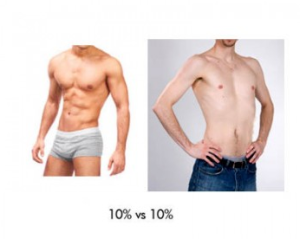
Is it possible for a thin person who regularly exercises to develop type 2 diabetes? Though 20% of type 2 diabetics are not overweight, what about their exercise habits?
Let’s take that a step further.
Of the non-overweight people with type 2 diabetes, how many have intense exercise regimens?
Misleading Journalism
The mistake that many writers make is that of implying that thin or non-overweight people necessarily engage in kickass workouts or have healthy diets.
One such misleading article title starts out as: Eat healthily and exercise regularly? You can still get Type 2 diabetes.
The first paragraph in that clumsy article is, “It is typically associated with eating too much and exercising too little – but one in ten people diagnosed with type 2 diabetes is a perfectly healthy weight.”
Do you immediately see the flaw? The follow-up line to the first sentence speaks only of “healthy weight” and makes NO mention of exercise.
In fact, nowhere in the rest of that article does it state anything about how normal-weight people who exercise “too little” are at risk for type 2 diabetes. The article talks only about WEIGHT.
So this circles back to the question: Can a non-overweight or “thin” person who does strenous workouts get type 2 diabetes?
Apparently there are no studies investigating this very specific question — that of strenous exercise, rather than more common forms of exercise.
Nevertheless, being of a normal body weight, in and of itself, does not guarantee immunity to type 2 diabetes.
The Development of Type 2 Diabetes
In type 2, the pancreas produces insulin, but — as one type 2 diabetic man once said — “the body doesn’t know what the hell to do with it.”
There’s an impairment in the transport system: insulin shuttling blood sugar to insulin receptor sites on muscle cells.
“As far as ‘normal’ weighted people developing type 2 diabetes, I will say diet and genetics are playing some role,” says Reena Patel, MD, a board certified family medicine physician who treats patients at Garnet Health Urgent Care in NY.
“Genetics play a greater role in certain races. The black, Native American and Asian community have the highest rates of diabetes, and this will continue to vary by each ethnicity.”
Muscle Protective Against Type 2 Diabetes
“We can also compare overall fat percentages even in a slim person,” says Dr. Patel.
“Belly fat, even if smaller, is worse than fat carried in other parts of the body, as it directly relates to increased insulin resistance.”
That’s a very compelling point, because a “healthy weight” person might also have the so-called skinny fat body, in which the body fat percentage is higher than what it should be for optimal health.
“The more muscle you have the greater your uptake of glucose into the cells,” says the Joslin Diabetes site.
More muscle means more insulin receptor sites.
Take a look at the two women below. They appear to be able to wear the same dress size, but the woman on the left clearly has more body fat.

Below is an accurate depiction of what two men with the same body fat percentage, but different physiques, might look like.
The man on the right is at higher risk for type 2 diabetes because he’s short on muscle mass. This means fewer insulin receptor sites. 
This doesn’t guarantee future type 2 for this body build, but it’s a risk factor. Who needs a risk factor for this disease?
“There is a general recommendation from the American Heart Association for a minimum of 150 minutes of exercise per week,” says Dr. Patel.
“This should be moderate or higher intensity and should get your heart going.
“Diet has also been compared between races living in different nations.
“A Western diet that is not controlled and contains high amounts of processed foods, sugars and fat can lead to type 2 diabetes.
“Overall research has shown genetic involvement is present but not huge, so I would focus on diet in a specific person as well as exercise per AHA guidelines — not for weight loss but for overall well-being from a cardiovascular and insulin standpoint.
“It appears aside from weight the same levels of inactivity and poor oral intake contribute the most towards the diagnosis.
“What else matters? Your lifestyle does! Excessive alcohol consumption, poor sleep, poor stress management and illegal substance abuse can contribute to insulin resistance.”












